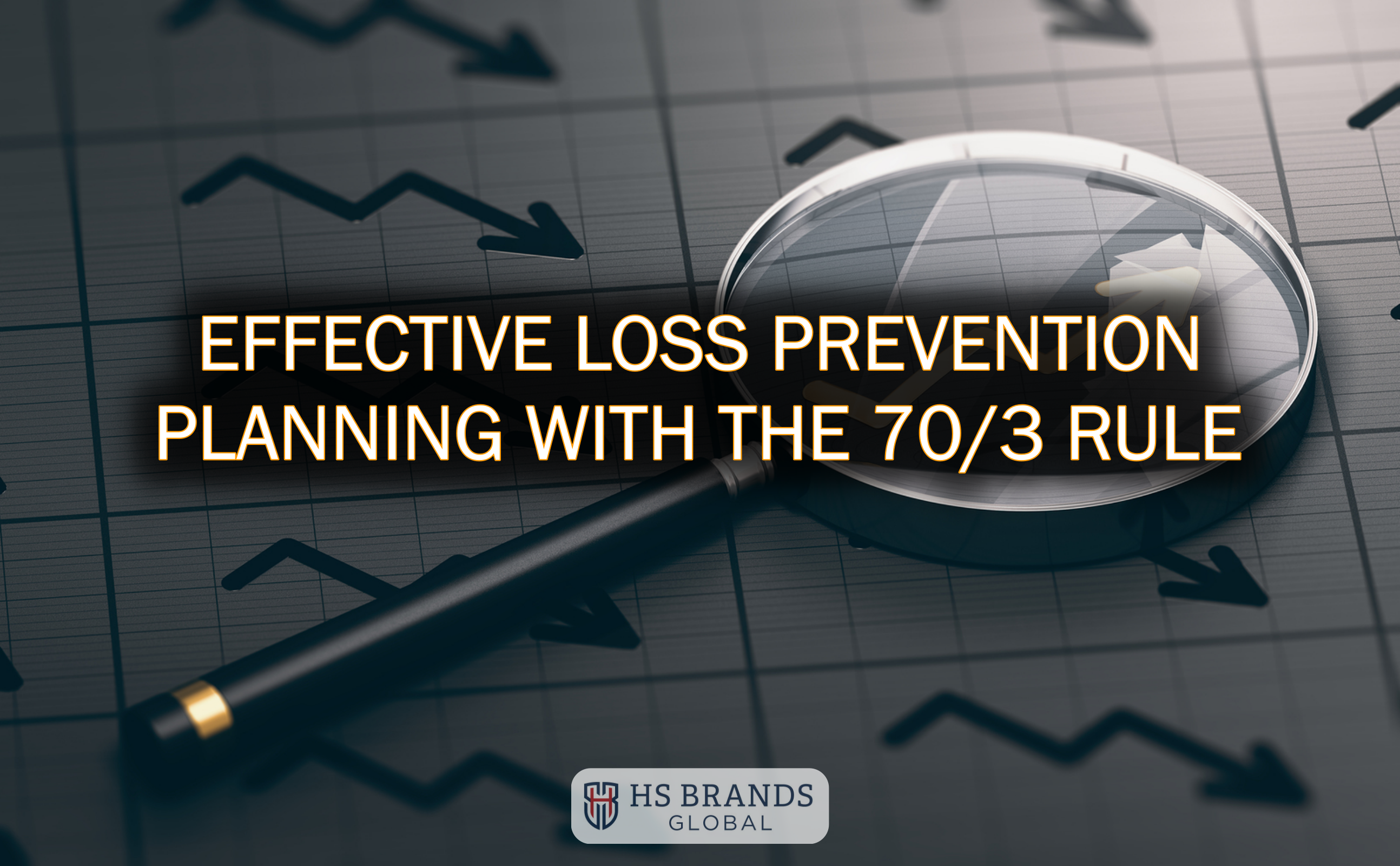
Building an effective loss prevention program requires strategic planning. The Loss Prevention 70/3 Rule produces better loss prevention results with less resource burn by creating a focus on the loss prevention activities that matter most.
I’m a planner. I have a passion for writing business plans. I have a spreadsheet for just about everything imaginable (which is why I’ve included a downloadable LP planner). It’s probably not hyperbole to say that the amount of my notebook expenditures is likely higher than my 401K investments.
That was not always the case. Back in my early loss prevention field investigation days, most of my paperwork lived on the backseat of my car, I relied more on memory than to-do lists, and I told a former supervisor that “December isn’t the time to do research, let’s just interview the guy.” So, no plan required.
Yeah, I cringe at that too. But youth—go figure.
Then I discovered Franklin-Covey and caught the planning bug. Twenty years later I still live by the “7 Habits” philosophy. However, of all the creeds, the one I found most useful was this:
Things Which Matter Most Must Never Be at The Mercy of Things Which Matter Least
The idea, of course, is easier to embrace than it is to execute. Even with the assistance of a priority matrix, humans tend to misinterpret the difference between things that are urgent and those that are important. We’re also not that great at determining an activity’s true value from the subjectively perceived value.
The unfortunate result is that often we are so engaged in tasks, to-dos, and productivity that we forget a fundamental tenet of success:
Don’t confuse effort with performance.
Let’s be honest. The Loss Prevention profession has become challenging. The job market is a little scarce, and there is significant pressure to prove value. Sometimes the easiest way to attempt to show our value is to produce lots and lots and lots of loss prevention stuff.
However, as Covey said:
Things Which Matter Most Must Never Be at The Mercy of Things Which Matter Least
Producing stuff is great unless all that stuff isn’t moving us toward our goal. Or worse, is getting in the way of our goal.
There is a method, however, to ensure that the loss prevention things that matter most get done. Also, by following this method, we maintain our focus on improving the performance of our associates, our stores, our company, and ourselves.
I call it the 70/3 Rule for Loss Prevention.
Yes, it’s a lot like the 80/20 rule with one crucial difference. The math supports the 70/3, so there is no guessing which percentage of activities provide the highest return on investment.
I’ll explain, but first, we have to agree that:
The most critical performance metric for loss prevention is the reduction of shrink or loss.
I said most important. There are other things to do. Some of these activities have high value, but they, too, must serve in loss reduction.
If your loss prevention philosophy contends there is a purpose or goal more valuable than the reduction of shrink or loss, then the 70/3 rule isn’t going to work as well for your program.
So, what is the rule?
The 70/3 rule contends that 70% of our losses come from just three behavioral conditions. By placing the majority of our efforts on correcting these three conditions we receive the highest return on our investment — and experience the most substantial reduction of losses.
The 70/3 Rule is the elimination of the three behaviors causing 70% of the loss.
Here are the three employees and their behaviors that are causing 70% of the losses:
Mr. & Ms. I Don’t Know: These employees lack proper training. They’re unaware of the proper procedures, processes or techniques. They make mistakes, and they miss opportunities to help reduce loss. With proper training, however, they will prove to be real assets to our goals.
Mr. & Ms. I Don’t Care: These employees know the right way. They either don’t care or believe their way is the better process. It might be that they can’t see the implications of their actions or they just have no concern for company health. With retraining or performance improvement plans we can either convert them to outstanding employees or recognize that they aren’t a good fit for our company’s culture.
Mr. & Ms. You’ll Wish You Were Here: These employees are dishonest. They come to work and place personal gain over all else. They wear many masks and may even be some of the happiest and most helpful folks on staff. However, when they think they can, they’ll act dishonestly. The only solution for this group is to detect, identify, and dismiss them.
The Most Successful LP Program Focuses on the Three Employees Causing the Losses
So, how did we deduce that these three types of employee behaviors are causing seventy percent of all the losses?
Decades of results from the National Retail Security Survey (NRSS) consistently indicate the three main causes of loss as employee theft, errors, and shoplifting.
The category averages over the past four years look like this:
- External Theft/Shoplifting = 38% of the losses
- Internal Theft/Dishonest Employees = 36% of the losses
- Errors, Mistakes, Unknown = 20% of the losses
✓ Total = 94% of reported losses
If we accept that 94% of the losses come from these (even if we disagree on the percentage break-out), and we conclude that all of the errors and mistakes are caused, at some level, by employee behavior (20%), and that all of the dishonesty is caused by employee behavior (36%) and that all least some of the shoplifting is due to employee inaction or active collusion (say 14%), we arrive at 70% of the losses being related to the three types of employees.
And yes, that was a very long sentence.
Based on the math, we can conclude that “if” we focus our attention on identifying and correcting those three behaviors, our efforts would target the 70% of things that are causing loss: the things that matter most.
But, as they say, the Devil is in the details.
An effective focus that results in a successful plan requires our program’s actions to identify the right issues and work toward their elimination.
I like planning in threes. So, the LP 70/3 plan breaks everything down into three parts as such:
We’ve identified the three employees and their behavior. We can summarize our three counter-actions as:
- Training
- Compliance Improvement
- Investigative Resolution (or simply dishonesty)
So, the things that matter most for achieving the thing that matters most (shrink/loss reduction) are training, compliance improvement, and resolution of dishonesty issues.
To create our 70/3 plan, we focus on the three actions that target the three most important issues.
- What three things can I teach employees that will provide the most significant ROI?
- Which three compliance issues, if corrected, would create the most significant improvement to store performance?
- Which three areas represent our most considerable risk for dishonesty and what three tools can we use to identify them?
The answers to these three questions become our action plan for working on the loss prevention things that matter most.
The most challenging part of the process is not coming up with a list of training topics, compliance issues, or investigative tools. The challenge is a commitment to focus on only three for each.
In some ways, it may feel counter-intuitive.
For example, you may have developed a very question-rich audit and struggle with a focus on just nine (three for each section) key questions. You can certainly have more, but these nine should be the most heavily weighted. (And truthfully, I’ve never seen employee name tags or their absence impact loss, so maybe that question belongs on a different type of inspection.)
The real value of this approach is that in conducting a serious and objective assessment of your program efforts by asking: “Is the time spent on these activities providing greater knowledge, insight, or actionable intelligence that will directly assist in the goal?”
Because if the answer is “no” then you’re not focusing on . . . The loss prevention things that matter most.
Click Here to Download the free Loss Prevention Rule of 70/3 Planner
———————————————————
Raymond Esposito
Director of Business Development & Marketing
HS Brands Global
Raymond Esposito has over 28 years of loss prevention experience, working within the department store, specialty, and grocery segments of retail. He has developed and executed loss prevention programs for over 125 retailers in the U.S., Canada, and the United Kingdom. He holds a bachelor’s degree in psychology from the University of Connecticut and is an expert witness.

